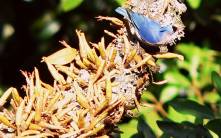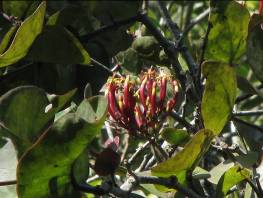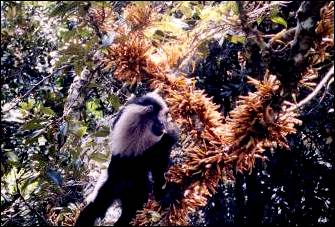Canopy Birds
|
|
R. Vivek D.R.Priyadarsanan and T. Ganesh
|
 |
Forest canopies are important for elucidating the structure and functioning of the forest bird communities. Canopies provide abundant food resources for birds in the form of leaves, flowers, fruits, arthropods and other organisms. Despite such occurrences, little work has been carried out on birds inhabiting and using this part of the forest especially in India, where bird studies have been restricted to ground based observations. This is the first attempt where canopy access has been employed to study bird communities in the wet forests of the southern Western Ghats. Eighteen canopy platforms have been established across a disturbance gradient in KMTR to carry out research.
Initially, the efficacy of sampling birds from the canopy was explored. Results revealed that ground-based studies provided inaccurate generalizations and gave way to biased results. A seemingly marked difference was observed in bird community composition and vertical strata use by birds across the gradient. Resource availability and habitat structure are major drivers that determine structural composition of the avian community. Due to structural change in habitat, the various avian guilds show resilience with the insectivores being most affected. Comparison of impacts of structural change of habitat on the small mammal and bird communities, and identifying indicators of change is currently being researched.
Velvet-fronted Nuthatch [credit: R.Vivek]

Epiphytes
|
|
Seshadri K.S, G. Kuriokose, R.Ganesan and M.S.Devy
|
 |
Epiphytes occurring in the forests of India have been sampled either from the ground or opportunistically. A study by us is now underway where the canopies have been accessed using SRT in Southern western Ghats to document the distribution of epiphytes in three dimensional space of the canopy. Light availability for epiphytes seemed a constraint for the wet forest canopy epiphytes. The probable orientation of epiphytes in an adaptable position to capture maximum sunlight is being investigated. The processes of epiphytes augmenting insect fauna through the canopy soil and litter they generate is also being investigated.

A canopy mistletoe [credit:Giby Kuriakose]
A clear trend of epiphyte orientation in the south west-south east direction orientation and a preference to branches that face skyward has been observed. The fauna supported by epiphytes at the inner zone of the canopy was found to overla in small proportions with the outer zone, reflecting the microclimatic and resource variations within the canopy. Through yet another study, complex interactions between the nectar-feeding birds and the mistletoes of the canopy is being unraveled.
Camera trapping
|
|
T. Ganesh and M.S. Devy
|
 |
The canopy offers very interesting challenges for documenting mobile organisms. Due to the three dimensional nature of the canopy space, the limitations involved in two dimensional sampling protocols are often questioned. Camera traps that are used to sample animals on the ground have also been employed to sample canopy dwelling species in KMTR, India. The lack of easy access and mobility curtails the positioning of camera traps in the canopy. In KMTR, the installation of passive infrared camera traps fixed to vertical branches overlooking a bait, which was either a flower or a fruit, to document frugivores was used. The cameras were activated in the canopy on a 24 hr mode for 2 to 3 weeks at a stretch. False triggering is a commonly encountered problem in canopies and during one such event the camera might consume all the loaded film in a matter of minutes. This problem was overcome by selecting exclusively large trees and thick branches that would remain stable in windy conditions. By overcoming such hurdles, most species, both diurnal and nocturnal, that inhabit the canopies of the south western ghats were documented. In addition, other parameters such as the visitation rates to flowers/fruits, nocturnal and diurnal activity and variations in visitation across the length of the season were also documented. These studies carried out over many years provided us with very valuable data on inter-year variations of the functional aspects of canopy process.

Camera picture Lion tail macaque on Cullenia:T.Ganesh
|



